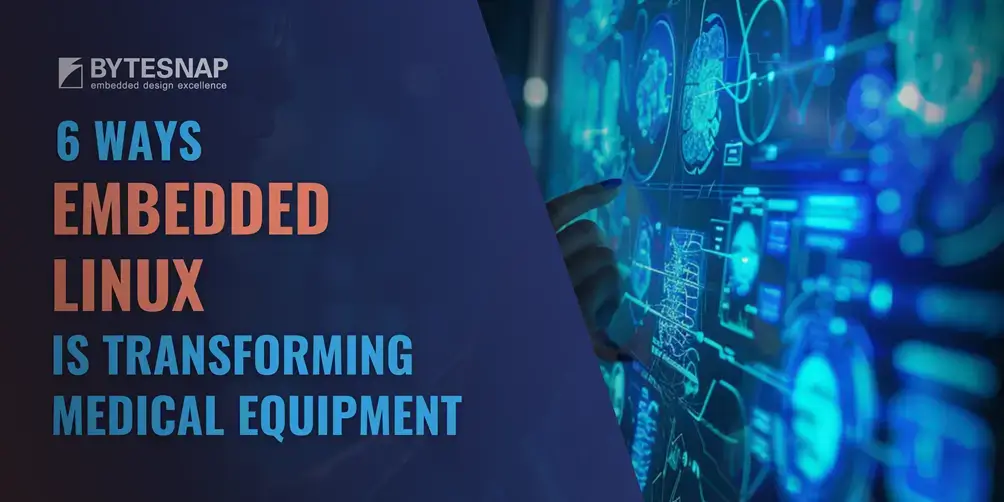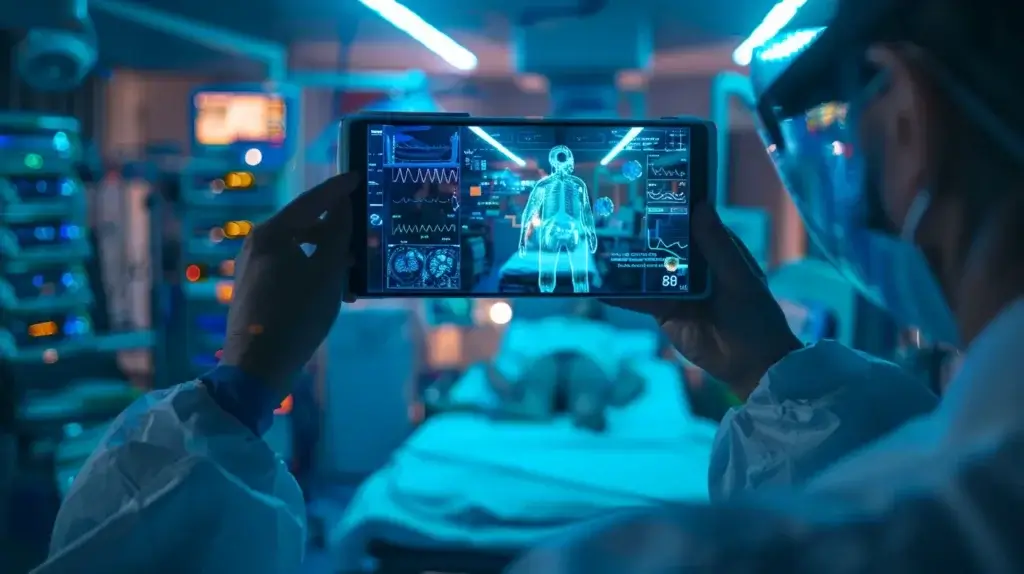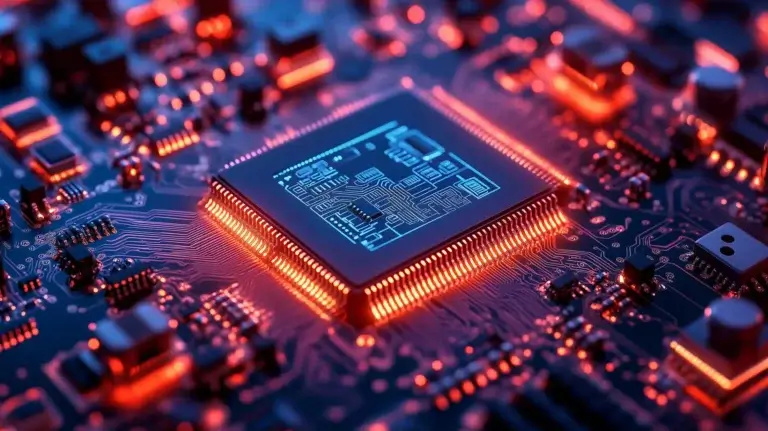6 Ways Embedded Linux is Transforming Medical Equipment
The integration of embedded Linux in medical devices has transformed the healthcare industry, offering enhanced connectivity, improved performance, and robust security.
The powerful and robust Linux kernel and available drivers and utilities allow new features when designing new medical equipment.
Let’s explore how embedded Linux is driving innovation and advancement in the healthcare industry.

1. The Rise of Embedded Linux in use in Medical Devices
Embedded Linux has gained traction for many medical equipment manufacturers where both safety critical and security conscious devices are needed.
Windows devices using Windows Embedded Enterprise or Windows Embedded Compact historically were used when developing these sophisticated user interfaces, networking stacks and data applications for medical devices.
These operating systems – although not suitable for critical care – would normally be paired with other microcontroller boards to provide both software needs in one enclosure.
Windows Embedded Compact (Windows CE) faded away many years ago for most developers. Now, even in the medical arena, it cannot be used due to its lack of security updates.
The choices are between:
- Windows 11 Embedded Enterprise, basically Windows desktop with some minor changes but all the windows bloat, power and resource requirements
or
- Embedded Linux with its stability, flexibility and support across a wide range of powerful ARM based chips.
Arguably Linux is a much better choice for developing sophisticated medical devices but there is still push back due to security concerns, ownership and responsibility of critical bug fixes, and worries over use of open-source software in this industry.
ByteSnap Design, a leading provider of embedded Linux, Windows, QNX and RTOS development services for medical devices, has been at the forefront of this technological transformation, harnessing the power of Linux to create innovative healthcare solutions.
Key Benefits of Embedded Linux in Medical Devices
- Enhanced Connectivity: Linux’s robust and well supported networking capabilities and extensive driver support will help drive improved connectivity
- Improved Performance: Fast processing power compared to Windows operating systems, thanks to Linux’s efficient kernel optimised for the features needed and without including unnecessary applications and services
- Robust Security: High level is given to include security fixes for the kernel or user space when they affect the product, these can be added on the manufacture’s timescales not a mass market rollout for a general purpose OS. Secure boot can be used to further enhance the system in a controlled way from the bootloader all the way to the file access
- Flexibility and Customisation: Including only the required kernel and user space features the reduced attack area is also reduced for hackers, the physical requirements for compute and storage as also reduced
- Cost-Effective Development: Although care should be taken the use of open-source libraries and development tools can greatly increase development productivity
2. Enhanced Connectivity and Remote Monitoring
One of the most significant advantages of embedded Linux in medical devices is the ability to implement advanced connectivity and remote monitoring features with ease.
This capability can transform patient care by enabling real-time data collection, analysis, and intervention.
A prime example of this technological advancement is the case study of GCE Healthcare‘s portable oxygen concentrator, developed by ByteSnap.
We successfully improved the device’s connectivity from 2G to Bluetooth and cloud integration, leveraging Linux’s mature networking and Bluetooth stacks and its broad driver support. This technological upgrade enabled:
- Real-time patient monitoring through continuous data streaming and analysis
- Remote device management, including firmware updates and configuration changes
- Improved data collection and analysis using Linux-based data processing and storage solutions
- Enhanced patient care and treatment optimisation through AI-driven insights and predictive analytics

3. Security and Certification in Medical Embedded Systems
When it comes to medical devices, security and certification are paramount. Embedded Linux development offers robust security measures to protect sensitive patient data and ensure device integrity using features like secure boot, file system encryption and tight control of the boot process.
The inherent security features of Linux, combined with ongoing community-driven security updates, provide a strong foundation for developing secure medical devices.
At ByteSnap, we work with companies implementing ISO 13485 certification for medical device development, applying stringent security protocols in their embedded Linux solutions.
4. Optimising Performance in Medical Imaging and Diagnostics

Embedded Linux systems have significantly advanced features that can be incorporated from GPU and NPU accelerated features for image processing, edge detection, de-noise, movement and many other features with common media frameworks such as GStreamer.
Along with video encoding, decoding, and streaming support, a high level of hardware assistance makes it an ideal platform for advanced medical imaging applications.
This optimisation allows for:
- Hardware integration leverages system on chip features like GPU/NPU and hardware blocks for image processing.
- High level of image processing libraries to aid in edge and image detection.
- Library support leveraging machine learning libraries optimised for embedded Linux systems offloading to GPU/NPU.
- Integration with existing hospital systems using standardised protocols and interfaces supported by other Linux libraries.
- Support of common programming languages such as .NET Core for Linux with support from Microsoft.
5. User Interface Development for Medical Devices
Intuitive user interfaces are key in healthcare settings, where ease of use can directly impact patient care.
ByteSnap’s SnapUI, a lightweight UI development tool optimised for embedded Linux systems, streamlines the creation of user-friendly interfaces for medical applications.
SnapUI offers several advantages for medical device UI development:
- Rapid prototyping and iteration using XML to describe UI layout along with Windows and Linux debugging support.
- Hardware acceleration for improved performance, leveraging OpenGL and other GPU-accelerated rendering techniques
- Multilingual support for global deployment, with Unicode support and localisation features built into the SnapUI framework
6. Future Trends: IoT and Cloud Integration in Medical Devices

The future of medical devices lies in the integration of IoT and cloud technologies, with embedded Linux serving as the foundation for these advanced systems.
ByteSnap’s IoT design services are paving the way for next-generation medical equipment that leverages these advanced technologies, leveraging Linux’s robust networking capabilities and extensive IoT framework support.
The Power of Embedded Linux in Healthcare
Embedded Linux has become an indispensable technology in the development of modern medical edge computing and data analysis equipment, serving as a robust, flexible, and secure foundation for innovative healthcare solutions.
From enhanced connectivity and security to improved performance and user-friendly interfaces, it continues to drive innovation in healthcare, enabling the creation of sophisticated medical devices that were previously costly due to many closed source operating systems.
Looking ahead, the incorporation of IoT and cloud technologies, supported by Linux’s comprehensive ecosystem, will profoundly transform patient care and medical diagnostics.
This integration paves the way for ongoing connected, intelligent healthcare systems.
For medical device manufacturers and healthcare providers looking to leverage the power of embedded Linux, partnering with experienced developers like ByteSnap Design can ensure the creation of cutting-edge, secure, and efficient medical equipment that meets the evolving needs of the healthcare industry.
These partnerships can facilitate the development of sophisticated Linux-based medical devices that also leverage advanced technologies.
For instance, real-time operating systems (RTOS) integration with other separate or integrated microcontroller subsystems, secure and robust with the ability to have either controlled over-the-air updates or in-person maintenance updates.
Ultimately providing the ability to migrate to future platforms as an incremental step rather than a software leap to the next operating system.
Summary
The adoption of embedded Linux in medical devices represents a paradigm shift in healthcare technology away from closed source operating systems such as Windows and QNX.
Its open-source nature, robust security features, and extensive ecosystem of tools and libraries make it an ideal platform for developing innovative, reliable, and cost-effective medical equipment.
The continuing evolution of embedded Linux in medical device design is likely to see further advancements in areas such as:
- Enhanced interoperability through standardised communication protocols and data formats
- Improved energy efficiency and battery life for portable medical devices using ARM based technology.
- Advanced security measures to combat emerging cybersecurity threats in healthcare using secure boot and encryption.
- Integration with emerging technologies such as augmented reality (AR) and virtual reality (VR) for medical training and procedures
- Development of Linux-based platforms for personalised medicine and laboratory data analysis purposes.
The future of healthcare technology is tightly linked to the capabilities and potential of embedded Linux.
As this powerful technology continues to adapt to the unique challenges of the medical field, it will undoubtedly play a pivotal role in shaping the future of healthcare delivery, patient care, and medical innovation.
By leveraging the power of embedded Linux and partnering with experienced developers, healthcare organisations can unlock new possibilities in medical technology, ultimately leading to improved patient outcomes and more efficient healthcare delivery systems.
Accelerate and future-proof your medical device designs

ByteSnap Design co-founder Graeme Wintle is one of the UK’s most experienced Microsoft Windows CE developers and is highly sought after for his expertise in migrating and security operating systems.
After graduating in Software Engineering from Newcastle University, Graeme quickly distinguished himself in software development at Nokia, GST Technology and Intrinsyc.
Graeme has been helping companies around the world with embedded software development for over twenty years. His cutting-edge design work has been instrumental in establishing ByteSnap at the forefront of embedded system design.
Graeme is the inventor of powerful, flexible user interface development framework, SnapUI.




